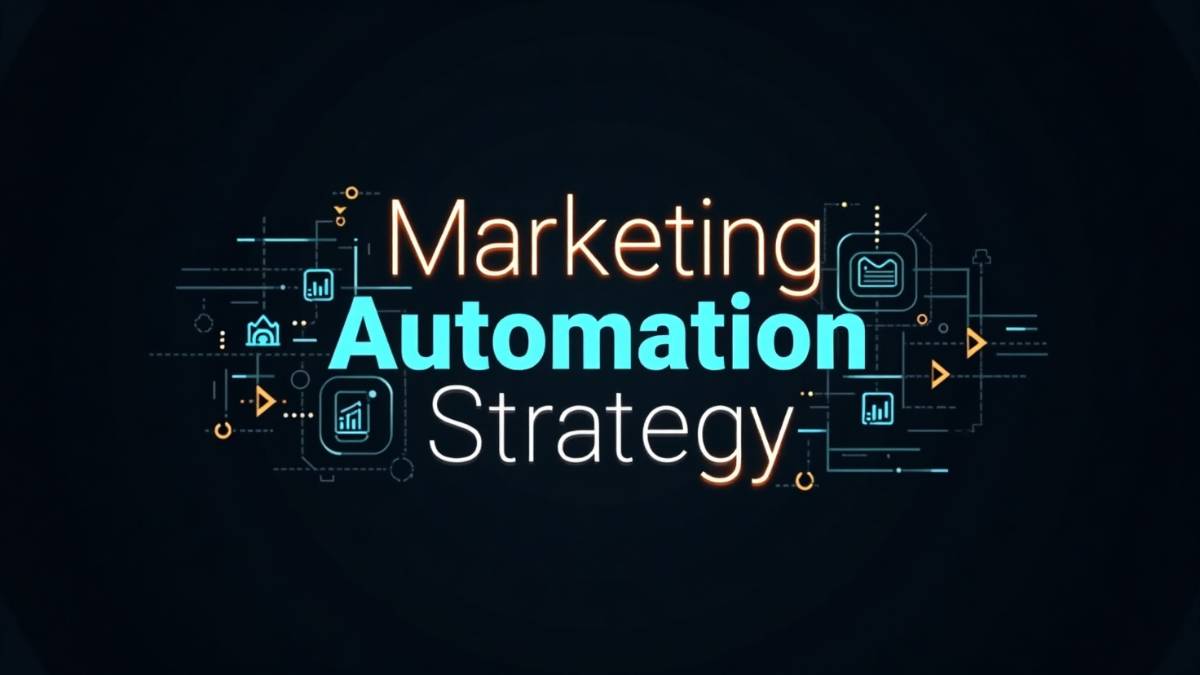Let’s be real: marketing in 2025 isn’t just about posting on social or blasting newsletters. It’s about smart systems, real-time personalization, and doing more with less. That’s exactly where marketing automation steps in – not as some cold, robotic thing, but as a strategic layer that helps you connect with customers better and grow revenue without burning out your team.
In this guide, we’re walking you through everything you need to know – from what automation actually is (hint: it’s not just email) to how to build a high-converting strategy that works in your business. Whether you’re running a lean startup or leading a mid-sized marketing team, this Marketing Automation Strategy guide is designed to get practical, not fluffy.
Table of Contents
What is Marketing Automation?
Marketing automation is the use of software and strategy to automatically handle repetitive marketing tasks – while personalizing customer experiences at scale.
But let’s make it real for a sec.
Ever received a welcome email after signing up for a freebie? Or maybe you got a discount email after abandoning your shopping cart? That’s marketing automation doing its thing – based on your behavior, not just random timing.
More than just sending emails, it’s a system that blends:
- Tools (like HubSpot or ActiveCampaign),
- Triggers (such as link clicks or form fills),
- And workflows (step-by-step journeys for each type of lead).
All so you can deliver the right message to the right person at the right time – automatically.
How Does Marketing Automation Work?
Imagine your marketing engine as a giant flowchart. Each customer action (like visiting a pricing page or downloading an eBook) triggers a response – whether it’s an email, a notification, a retargeting ad, or even a task for your sales team.
Here’s how it usually works behind the scenes:
1. Trigger-Based Actions
Someone fills out a form → they get a follow-up email
Someone visits a product page multiple times → they’re added to a retargeting audience
Triggers are based on behavior, and they initiate the right response – all without a human manually doing anything.
2. Behavior Tracking
Most platforms track user actions: email opens, clicks, website activity, even video watch time. This data feeds into personalization and lead scoring.
3. CRM and Platform Integration
Marketing automation tools connect with:
- CRMs (like Salesforce, Zoho, or HubSpot)
- Email marketing platforms
- Ad platforms (like Facebook Ads or Google Ads)
- SMS tools, chatbots, and more
It’s this interconnected web that allows the automation to feel seamless (and smart).
Key Features of Marketing Automation Software
Let’s talk features – the things that actually make automation work. The best tools out there give you these core capabilities:
1. Email Campaign Management
Schedule newsletters, send follow-ups, and trigger sequences based on what users do.
Example: If someone opens your email but doesn’t click, you can automatically resend with a new subject line.
2. Lead Scoring and Qualification
Assign points to leads based on their actions.
Visited the pricing page? +20 points.
Clicked an email link? +10 points.
This helps sales teams know who’s hot and who’s just browsing.
3. Drip Campaigns
Automated sequences that nurture leads over time. Think of it like a slow-burn conversation with someone who isn’t ready to buy – yet.
4. Multi-Channel Integration
Your audience isn’t just hanging out in one place. Good automation platforms connect:
- Email
- SMS
- WhatsApp
- Social Media
- Paid Ads
And let you craft journeys that move across these.
5. A/B Testing and Reporting
No more guessing. A/B test subject lines, content, CTAs – and track metrics like open rates, click-throughs, and conversion.
Also Read: A/B Testing vs Multivariate Testing
6. CRM Integration
This is where sales and marketing start to actually talk to each other. When your CRM knows what your leads are doing, follow-ups become 10x more relevant.
7. Customer Journey Mapping
Visual tools let you map out what happens at every stage – from awareness to decision.
(If you’re a visual thinker, this part is gold.)
Types of Marketing Automation
Marketing automation isn’t a one-size-fits-all tool. It spans across different use cases depending on your goals.
1. Email Automation
Still, the backbone for most brands. Think:
- Welcome series
- Abandoned cart reminders
- Upsell and re-engagement campaigns
Also Read: Top AI Email Writers
2. Social Media Automation
Tools like Buffer or Hootsuite can schedule posts, respond with auto-replies, and even repost evergreen content.
3. Lead Nurturing Workflows
If your sales cycle is longer (especially B2B or SaaS), you’ll need multi-step journeys that slowly educate and engage.
4. Customer Segmentation
Automatically group your contacts by behavior, interests, or demographics. This is what makes personalization actually work.
5. Analytics and Reporting Automation
Why spend hours manually compiling reports? Automation can show you campaign ROI, top-performing assets, and drop-off points in real-time.
6. Chatbot and Conversational Automation
Think Drift, Intercom, or ManyChat. These tools greet visitors, qualify leads, and even book demos – without needing a live person on standby.
What Marketing Automation Can Do for Your Business
Okay, enough theory. Let’s ground this with some real-world use cases.
1. eCommerce: Abandoned Cart Recovery
You visit a site, add something to cart… but don’t check out. Three hours later, you get a reminder email – maybe even with a 10% discount. That’s automation, and it works really well.
2. SaaS: Onboarding Sequences
New user signs up → gets a welcome email → followed by a product tour → then a helpful tip every 2 days.
This kind of drip sequence can double your activation rate.
3. EdTech: Nurturing Trial Users
Trial expires in 3 days? Send a helpful use-case video. Didn’t upgrade? Follow up with a limited-time offer.
4. B2B: Lead Qualification and Follow-Ups
Someone downloads your whitepaper? Assign them to a drip flow. Visit the pricing page? Alert the sales rep to follow up.
Also Read: Build a Successful Facebook Marketing Strategy
How to Build a Marketing Automation Strategy
This is it – the real goldmine of the guide. If you take one thing away from this blog, let it be this section.
There’s a difference between “using marketing automation tools” and having an actual automation strategy. The first one feels random – like setting up some email flows and hoping for the best. The second? It’s intentional. Measurable. And it gets results.
Here’s a step-by-step breakdown to build your own strategy:
Step 1: Define Your Goals Clearly
It sounds obvious, but most teams skip this or stay too vague.
Start with specific goals like:
- Generate 500 MQLs in 3 months
- Increase product demo bookings by 25%
- Reduce churn by nurturing trial users
- Upsell 20% of existing customers to a premium plan
If you’re not clear on what success looks like, your automation is just noise.
Step 2: Set Benchmarks and KPIs
What metrics will tell you things are working?
Some examples:
- Email open rate: Are people even paying attention?
- CTR (Click-through rate): Are they engaging?
- Lead score thresholds: Who’s ready for sales?
- MQL → SQL conversion rate: Is marketing passing good leads?
- Time to conversion: How long does it take?
Set current benchmarks, then define your target KPIs. This will guide your tweaks later.
Also Read: What are Marketing Metrics?
Step 3: Map the Customer Journey
Here’s where it gets strategic.
Think about the entire journey – from stranger to loyal customer. Where are the friction points? Where do people drop off? Where do they need a nudge?
Try to outline:
- Awareness stage (first touchpoints)
- Consideration stage (education and nurturing)
- Decision stage (follow-ups, demos, offers)
- Post-purchase (onboarding, upsell, retention)
Use tools like Miro, Whimsical, or even a messy whiteboard sketch. Doesn’t need to be fancy – it just needs to show how your users move.
Step 4: Choose the Right Automation Tools
Now that you know what you want to build, let’s talk tools.
Here’s a quick rundown of some popular ones – each has its strength:
| Tool | Best For | Why You Might Like It |
| HubSpot | All-in-one CRM + automation | Easy UI, great for B2B |
| ActiveCampaign | Behavior-based flows | Powerful logic, great value |
| Brevo (Sendinblue) | SMEs on a budget | Affordable and growing fast |
| Klaviyo | eCommerce brands | Built for Shopify, deep customer data |
| Mailchimp | Beginners | Easy to use, good templates |
No one tool fits everyone – pick based on your team size, use case, and budget.
Step 5: Create Campaign Workflows & Collateral
Now the real fun begins.
Think of your workflows like mini-stories:
- What’s the trigger?
- What happens next?
- How many emails?
- What content goes where?
You’ll need:
- Emails (Welcome, reminders, upsells, etc.)
- Landing pages (for lead magnets or sign-ups)
- CTAs and tags to track activity
- Defined triggers (like form fills, clicks, etc.)
Try not to overthink every line. Just get version 1 live – you’ll improve it with real data.
Step 6: Collaborate Across Teams
This part is so often missed.
Your automation strategy touches:
- Marketing (obviously)
- Sales (lead handoffs, follow-ups)
- Product (especially for onboarding flows)
- Customer support (retention, win-backs)
Loop them in early. Agree on lead definitions. Build shared dashboards. Create alignment. Otherwise, your automation can feel disconnected – or worse, confusing to the customer.
Step 7: Implement and Test the Automation
Time to hit “publish”? Not quite.
- Test every flow.
- Check email deliverability.
- Run A/B tests – especially on subject lines and CTAs.
- Preview what users will actually experience.
Broken flows kill trust. A simple typo in a trigger or wrong link can confuse (or lose) a lead. It’s worth double-checking.
Step 8: Review, Optimize, Repeat
Here’s the truth: no strategy is perfect on Day 1.
You will need to adjust things based on performance:
- Tweak email timings
- Rethink messaging if CTRs drop
- Update segments as lists grow
- Refresh your content and visuals
Review your dashboards weekly (or monthly at minimum), and always ask: Is this getting us closer to our goals?

Enroll Now: Advanced Generative AI for Marketing
How to Get Started With Marketing Automation
Feeling overwhelmed? No worries – here’s a super simple way to get started:
Step 1: Audit Your Current Marketing
Start by asking yourself: what marketing stuff are we doing over and over again? Are you manually sending follow-up emails? Copy-pasting leads into a spreadsheet? If it feels repetitive and boring, there’s probably a way to automate it.
Step 2: Identify Bottlenecks
Where are things slowing down? Maybe leads come in but don’t get followed up on. Or sales spends too much time on people who were never a fit. Find the biggest pain points, those are usually where automation can help the fastest.
Step 3: Set Up a Basic Drip Campaign
Don’t try to build everything at once. Pick one simple flow, like a welcome email series when someone signs up. Write 3–5 helpful emails, space them out a bit, and let the sequence warm up new leads on autopilot.
Step 4: Connect Your CRM and Lead Sources
Now, make sure your tools are talking to each other. If someone fills out a form, it should show up in your CRM, no copy-pasting. Use native integrations or something like Zapier to connect the dots. It doesn’t have to be fancy.
Also Read: AI in Marketing Strategy
Tools to Consider for Marketing Automation
If you’re still shopping around for tools, here are some solid picks (with why they’re worth checking out):
- HubSpot – Clean UI, built-in CRM, great for growing teams. Expensive, but scalable.
- ActiveCampaign – Super powerful for building behavior-based sequences. Great value.
- Brevo (Sendinblue) – Ideal for small to mid-size businesses. SMS + Email + CRM in one.
- Klaviyo – Made for eCommerce. Ties directly into Shopify and segments like a beast.
- Mailchimp – Beginner-friendly, decent automation, lots of templates. Easy to test with.
Also Read: How to create an Omnichannel Marketing Strategy
Conclusion
If you’ve made it this far – first of all, thank you. Second, let this be your reminder:
Marketing automation isn’t about replacing humans – it’s about empowering them.
It helps you deliver smarter campaigns, not just faster ones. It keeps leads warm, makes follow-ups instant, and keeps your funnel moving – even while your team is sleeping (or bingeing Netflix, we don’t judge).
So whether you’re just dipping your toes in, or planning to overhaul your entire funnel – start with clarity, stay consistent, and keep optimizing.
Frequently Asked Questions
Q1. What is the difference between email marketing and marketing automation?
Email marketing is one part of automation. Automation is broader – it’s about building smart, triggered workflows that span email, SMS, ads, and more.
Q2. How long does it take to see results from marketing automation?
Q1. What is the difference between email marketing and marketing automation?
Email marketing is one part of automation. Automation is broader – it’s about building smart, triggered workflows that span email, SMS, ads, and more.
Q3. What industries benefit most from marketing automation?
Honestly? Almost all. But especially: eCommerce, SaaS, EdTech, B2B services, and real estate.
Q4. Is marketing automation suitable for small businesses?
Absolutely. Even a basic welcome series or lead scoring setup can be a game-changer. Tools like Brevo or Mailchimp make it affordable, too.
Q5. What is the best marketing automation tool for beginners?
Mailchimp is easy to start with. Brevo and ActiveCampaign are great next steps if you need more logic and segmentation.
Q6. How do I measure the success of my automation strategy?
Look at KPIs like conversion rates, open/click rates, lead velocity, and ROI. But also measure qualitative things – like lead quality and team productivity.

